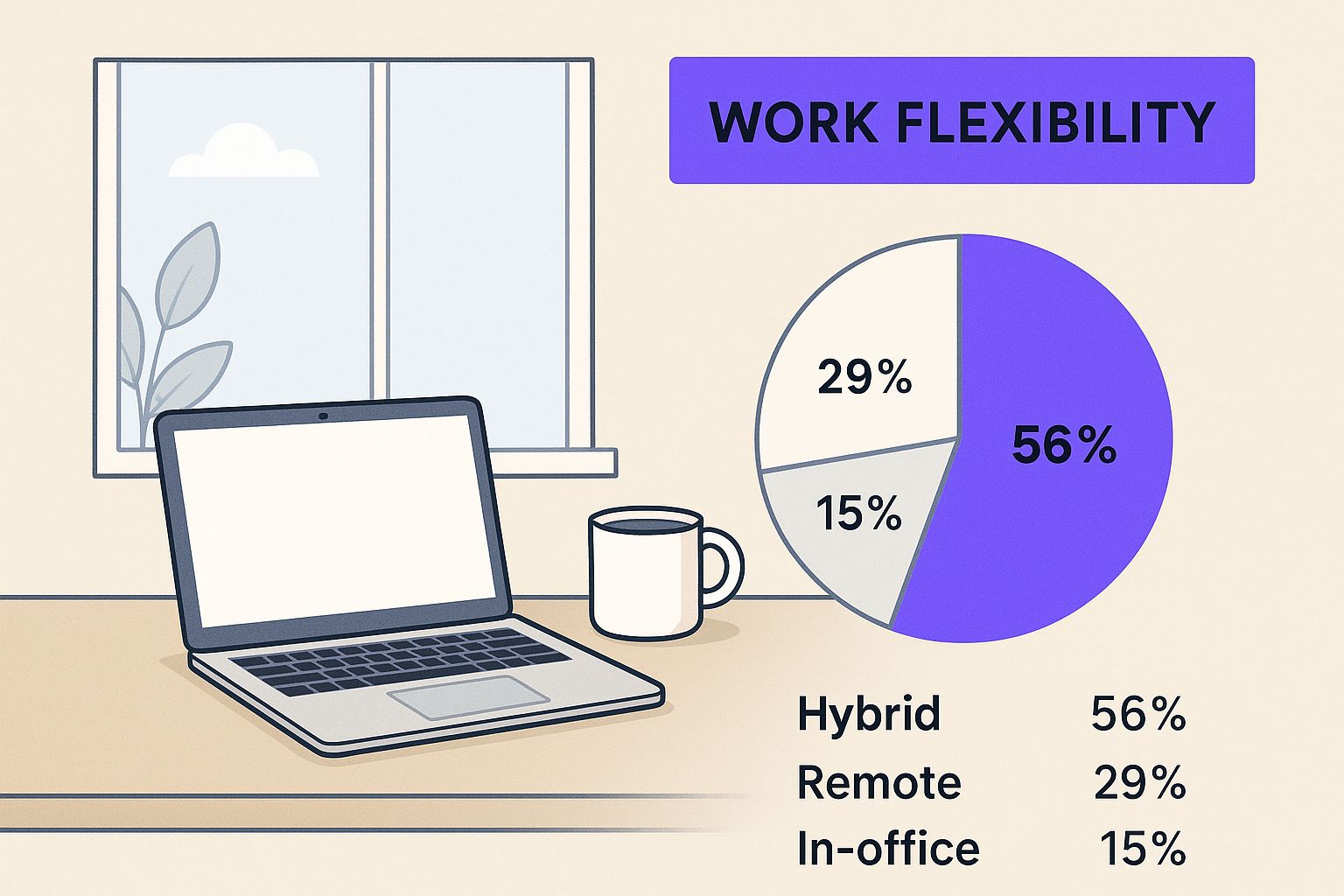What an Asynchronous Work Schedule Really Means
Move past the idea of a rigid 9-to-5 schedule where everyone clocks in and out at the same time. An asynchronous work schedule is more than just flexible hours; it represents a different way for teams to collaborate and achieve results. Think of it like a skilled jazz band. The musicians don't all play their instruments at once. Instead, each member contributes their part when it best fits the music, coming together to create a rich and complex piece. In the same way, an asynchronous model lets team members work during their most productive hours, rather than requiring everyone to be online together.
This approach separates work from a specific time of day. It shifts the focus from immediate responses to thoughtful, well-documented communication. The primary goal is to keep projects moving forward without depending on everyone being available at the same moment. This is becoming a cornerstone of modern work, with projections indicating that 22% of the American workforce will work remotely by 2025—that’s about 32.6 million people. As more teams spread across different cities and time zones, the need for effective async practices becomes essential. You can explore more remote work statistics here.
Synchronous vs. Asynchronous Work
To fully understand asynchronous work, it helps to see it next to its opposite: synchronous work. The main difference is the expectation of real-time interaction.
| Aspect | Synchronous Work (The Orchestra) | Asynchronous Work (The Jazz Ensemble) |
|---|---|---|
| Pacing | Everyone works in unison, following the manager's lead like a conductor. | Team members contribute at their own pace, guided by a shared project plan. |
| Communication | Depends on instant feedback through meetings, calls, and live chats. | Relies on clear records like project briefs, recorded videos, and detailed comments. |
| Decisions | Made quickly in live discussions, often with pressure for an immediate response. | Made deliberately after everyone has time to review information and share their thoughts. |
| Focus | Often broken by constant notifications and scheduled meetings. | Protects "deep work" time, allowing for focused and uninterrupted effort. |
This comparison highlights how an asynchronous model builds on different values to help teams reach their goals.
The image above shows how remote work adoption varies globally, reflecting how different cultures and infrastructures shape this trend. This global spread makes it clear why a single, universal work schedule is no longer effective for international teams.
Busting Common Async Myths
Even with its clear advantages, some misunderstandings about the asynchronous work schedule still exist. One common myth is that it slows down decision-making and weakens accountability. However, with the right systems in place, the opposite is often the case. Teams using this model trade rushed, reactive decisions for well-reasoned, strategic ones.
Another myth is that async work damages team culture by limiting interaction. In reality, it encourages more purposeful and meaningful communication. This fosters a culture built on trust and individual autonomy. This approach isn't about working less—it's about working smarter by matching tasks to natural energy levels and personal schedules. If you want to learn more, you can check out our detailed guide on asynchronous work for more practical tips.
Why Smart Teams Are Embracing Async Schedules
Shifting to an asynchronous work schedule is more than a nod to flexibility; it's a strategic decision to help your team perform at its best. The biggest advantage is creating space for deep work—those essential, long stretches of focus where big ideas are born and high-quality work gets done. When team members aren't constantly interrupted by meetings or the pressure of instant replies, they can properly engage with complex challenges. This kind of environment is especially valuable for creative and technical roles, where deep thinking directly impacts the quality of the final product.
This protected focus time translates into real productivity improvements. For instance, employees who work entirely remotely, often using asynchronous methods, gain about 51 more productive minutes per day compared to their office-based counterparts. This isn't just about working longer; it's about working smarter. You can find more data on this dynamic in the full 2025 ActivTrak report.
The infographic below illustrates just how central work flexibility has become in the modern workplace.

This visual highlights that giving people control over their schedules is a powerful way to attract and keep great talent.
Improved Decision-Making and Inclusivity
An asynchronous approach changes the very nature of team decisions. Instead of favoring the quickest thinkers or the most dominant voices in a meeting, it encourages thoughtful and well-argued contributions. When a new idea is shared in a document, everyone gets the time they need to review the information, do their own research, and form a solid opinion. This process naturally improves the quality of feedback and leads to better, more strategic decisions.
To give you a better idea of how async and sync work styles stack up, here’s a comparison of their typical outcomes.
| Work Style | Productivity Gain | Creative Output | Employee Satisfaction | Meeting Hours |
|---|---|---|---|---|
| Asynchronous | High (Focused deep work) | High (Time for reflection) | High (Autonomy) | Low (Fewer, more purposeful meetings) |
| Synchronous | Variable (Interruption-driven) | Moderate (Group brainstorming) | Variable (Depends on culture) | High (Default for communication) |
This comparison shows that asynchronous work can lead to significant gains in productivity and creativity by protecting individual focus time, a key factor in employee satisfaction.
This model also creates a more inclusive workplace. Here’s how:
- Neurodiversity: For team members who are neurodivergent, the constant stimulation of a traditional office can be taxing. Async work lets them manage their surroundings and work in a way that suits their cognitive style.
- Global Talent: It removes time zone constraints, enabling companies to hire top talent from anywhere in the world without requiring employees to work odd hours.
- Reduced Meeting Load: Teams that adopt async practices have reported cutting their meeting time by as much as 60%. This frees up schedules for actual work and reduces "Zoom fatigue," boosting both team morale and project results.
By emphasizing clear documentation and giving individuals time to focus, an asynchronous schedule empowers every team member to contribute their best. This makes the entire organization more effective and adaptable.
How Different Countries Master Async Work Styles
An asynchronous work schedule isn’t a one-size-fits-all model. The way it's used is deeply connected to local culture, technology, and work philosophies. By looking at how different regions adapt async principles, any team can find useful ideas. Globally, the approach changes based on infrastructure and cultural norms. For instance, some of the highest rates of working from home are found in North America, the United Kingdom, and Australia, where the company culture is often ready for remote work. You can find more details on these trends in the working from home data from Stanford.

This global perspective is essential for understanding how to successfully roll out an asynchronous work schedule across teams from different backgrounds.
The Silicon Valley Model: Pioneering Flexibility
In the tech centers of North America, especially Silicon Valley, companies have long been early adopters of flexible work. Here, the async model is often driven by the need to attract top talent from anywhere in the world and a sharp focus on fast-paced innovation.
- Emphasis on Documentation: Teams make it a priority to create a single source of truth for every project. This clear documentation reduces the need for constant real-time meetings.
- Outcome-Oriented Culture: Success is measured by the results you deliver, not the hours you spend at a desk.
- Tool-Centric Collaboration: There is a heavy reliance on advanced project management and communication software to keep everyone aligned.
This approach is a great fit for fast-moving environments where individual freedom and high performance are core values. It’s a blueprint for teams that want to prioritize speed and independence.
The Scandinavian Approach: Sustainable Work-Life Integration
In Scandinavia, the approach to async work is built around well-being and sustainability. The goal isn't just about maximizing productivity but about creating a healthy, long-term balance between work and life.
- Clear Boundaries: There is a strong cultural expectation to disconnect after work hours, a rule that is respected even in an asynchronous environment.
- High-Trust Environment: Management trusts employees to get their work done without constant supervision, a principle that aligns perfectly with async ideals.
- Focus on Core Hours: Many companies use a hybrid model. They set aside limited "core hours" for necessary live collaboration, leaving the rest of the day flexible for focused work.
This model shows how an asynchronous work schedule can improve employee well-being, which often leads to lower burnout rates and greater job satisfaction.
Adapting Async in Asia: A Hybrid Approach
In many Asian business cultures, teamwork and group harmony are highly valued and often built through in-person interaction. Because of this, adopting a fully asynchronous schedule can be a more gradual process. Many companies are finding success with a hybrid model that mixes traditional values with new flexibility. They might use async principles for individual tasks but keep scheduled meetings for key decisions and team-building. This shows a path for bringing async work into cultures with strong collaborative traditions, proving that flexibility can be adapted to fit different company values across the globe.
Overcoming Real Async Work Schedule Challenges
While an asynchronous work schedule offers incredible benefits like deeper focus and more autonomy, it’s not a magic wand that makes all workplace problems disappear. Moving to this model means you’ll face a new and predictable set of hurdles. The most common obstacles teams run into are communication delays, the risk of employee isolation, and finding the right balance between flexibility and accountability. Getting past these requires deliberate effort and clear strategies.
Managing Communication and Decision-Making Delays
One of the first frustrations teams feel is the communication lag. When you need a quick decision or feedback on something urgent, waiting hours for a reply can feel like hitting a brick wall. This is especially true for teams accustomed to getting instant answers in person or through constant messaging.
To fix this, successful async teams create systems to handle urgent issues without causing a synchronized panic.
- Establish Clear Communication Protocols: Define what truly counts as an emergency. Create a specific, rarely used channel or process for urgent matters that warrants interrupting someone's deep work.
- Set Response Time Expectations: Agree on realistic timeframes for replies. For instance, a 12-hour or 24-hour response window for non-urgent messages can become the team standard, which removes the anxiety of waiting for an immediate response.
- Over-Communicate with Context: Encourage everyone to provide as much detail as possible in their initial message. This simple step cuts down on the back-and-forth questions that drag out timelines. A well-written request allows a colleague to give a complete answer in one go.
Preventing Isolation and Fostering Team Culture
The absence of spontaneous, face-to-face moments can make some team members feel isolated. The casual "water-cooler" chats and shared lunches that build friendships are missing in a fully asynchronous setup. Keeping a strong team culture alive requires creating intentional connection points that are separate from work tasks.
For example, a dedicated channel in a tool like Slack for non-work chat is a simple but powerful way to build social bonds.
This type of informal channel gives people a place to share personal news, hobbies, and jokes, mimicking the casual social side of an office. These spaces are essential for humanizing colleagues and building the trust needed for great collaboration. You can find more ideas by exploring guides on what is asynchronous collaboration and its best practices.
Here are a few other proven ways to keep team culture strong:
- Schedule Optional Socials: Set up virtual coffee breaks, online game sessions, or "show and tell" meetings that are purely for fun, with no work agenda.
- Create Shared Interest Groups: Support channels or groups based on hobbies like books, movies, fitness, or cooking.
- Celebrate Wins Publicly: Use a specific channel to share praise, recognize achievements, and celebrate milestones, both at work and in life. A study on workplace distractions revealed that 79% of employees couldn't work for an hour without being interrupted, so creating dedicated, non-intrusive spaces for celebration is a smart move.
By planning for these challenges and putting practical solutions in place, your team can enjoy the major benefits of an asynchronous work schedule while managing its drawbacks. It all comes down to building a system based on trust, clarity, and intentional connection.
Essential Tools That Make Async Work Actually Work
Making the shift to an asynchronous schedule is more than a change in habits—it requires the right digital tools to hold everything together. The idea isn't to collect as many apps as possible, but to build a connected system that replaces real-time check-ins with clarity and trust. Think of this toolset as your team’s virtual office, where information is always available and projects move forward smoothly, no matter the time zone.
The right technology acts as the glue for your asynchronous strategy. A solid project management platform, for example, becomes your new daily stand-up meeting. A well-organized documentation tool acts as the team's shared brain. Success with an asynchronous work schedule hinges on choosing systems that prioritize clear communication and empower everyone to work with confidence.
Your Core Async Tech Stack
A strong async setup typically stands on three pillars: a project hub for managing tasks, a communication platform for team interaction, and a knowledge base for storing information. Together, they ensure that work, conversations, and essential documents are organized and easy to find.
- Project Management Hub: This is where the work gets done. Tools like Asana, Trello, or Jira replace spoken updates with clear tasks, deadlines, and visible progress. The goal is to find a platform that allows for detailed task descriptions and threaded comments, keeping all conversations about a specific job right where they belong.
- Communication Platform: It might sound strange, but a messaging tool like Slack or Microsoft Teams is vital for async work. The trick is to use it asynchronously—favoring thoughtful, detailed messages over rapid-fire chats. To learn more, check out our guide on asynchronous communication best practices and explore this effective Slack communication playbook for specific tips.
- Knowledge Base (or Digital Brain): This is perhaps the most important piece of the puzzle. A central place for all documentation, processes, and company information is a must-have. This "single source of truth" prevents delays because team members can find answers themselves instead of waiting for a reply.
A tool like Notion is a great option for a knowledge base, as it combines documentation with light project management features.

The image above shows how teams can create connected pages for project plans, meeting notes, and company-wide objectives, making information easy for anyone to find.
Smart Integration Is Key
The real power of an async tech stack is unlocked when these tools work together. For instance, creating a new task in your project management tool can automatically send a notification to a specific Slack channel. A decision recorded in a Notion meeting summary can be linked directly inside a related task in Asana.
Before we explore how these integrations work, let's break down the essential tool categories your team will need. The table below outlines the primary function of each category, top recommendations, and key features to look for based on your team's size.
| Tool Category | Primary Function | Top Recommendations | Key Features | Team Size |
|---|---|---|---|---|
| Project Management | Track tasks, deadlines, and progress | Asana, Trello, Jira | Task dependencies, timelines, threaded comments, custom fields | All Sizes |
| Team Communication | Centralized conversations and updates | Slack, Microsoft Teams | Channels, threads, integrations, status updates | All Sizes |
| Knowledge Base | Document processes and information | Notion, Confluence, Slab | Searchable content, version history, templates, permissions | 10+ |
| Video Messaging | Record and share screen recordings | Loom, Vidyard | Screen recording, transcripts, commenting on video | All Sizes |
| Document Collaboration | Create and co-edit documents | Google Workspace, Microsoft 365 | Real-time editing, version control, comment threads | All Sizes |
| Design Collaboration | Share and get feedback on designs | Figma, Miro | Prototyping, commenting, whiteboarding, versioning | 5+ |
Table: Essential Async Work Tool Categories
Comprehensive breakdown of tool types, recommended platforms, and key features for asynchronous team collaboration
This table highlights that the right tools depend on your specific needs, but every async team needs a way to manage projects, communicate, and document knowledge.
This connected system ensures nothing is missed and reduces the manual work of keeping multiple platforms updated. A well-chosen toolset doesn't just enable an asynchronous schedule; it makes your team more efficient, transparent, and prepared to grow.
Creating Your Custom Async Work Schedule Framework
Switching to an asynchronous work schedule isn't about flipping a switch from on to off. Think of it more like building a new foundation for how your team collaborates. The first step is to figure out which parts of your operation are a good fit for this model. Not every role or project gains the same advantages from async work. A graphic designer, for instance, could flourish with long, uninterrupted blocks of focus time, making their role an ideal candidate. On the other hand, a live customer support agent will likely need a hybrid approach to guarantee someone is always available.
Once you have a sense of who and what will go async, it's time to set some clear ground rules. An async model doesn’t mean a complete free-for-all; in fact, it often requires more deliberate structure and communication, not less. This is where a team "async charter" or a set of working agreements is essential. This document should outline your team’s shared understanding of communication, availability, and project handoffs.
Establishing Core Collaboration Hours and Protocols
Even in a mostly asynchronous setup, you’ll still need some real-time connection for brainstorming, complex problem-solving, or sensitive discussions. The goal is to make this synchronous time minimal but highly effective. Instead of a rigid 9-to-5, find a small window of core collaboration hours that accommodates all your team’s time zones. This might only be a couple of hours, a few times per week.
With your core hours in place, the next step is to build solid communication protocols. This is the bedrock of a healthy async environment.
- Define Realistic Response Times: Set clear expectations for non-urgent messages. A standard 24-hour response window for most inquiries can lower stress and remove the pressure to be constantly online.
- Create Communication Tiers: Not every message has the same urgency. Clarify what an emergency looks like versus a standard request. For example, a question about a project brief belongs in your project management tool, while a system-wide outage might trigger a notification in a dedicated high-alert channel.
- Promote Detailed, Context-Rich Messages: Train your team to over-communicate in their initial message. The aim is to provide enough background and detail for the recipient to act on the request without a long chain of back-and-forth questions.
The Power of Documentation and Feedback Loops
A key element of any successful async workplace is clear, easy-to-find information. This is why knowing how to write documentation that teams actually love is so important. When people can find answers on their own, it breaks down bottlenecks and gives them the power to move forward independently. Your documentation should be a single source of truth for everything from project plans and process guides to meeting notes and company policies.
Finally, remember that no framework is perfect right out of the gate. An effective asynchronous work schedule grows and adapts with your team. Build in regular feedback loops to see what’s working and what needs adjusting.
- Regular Surveys: Use simple, anonymous surveys to check in on team satisfaction with the async setup.
- Dedicated Retrospectives: Use your core collaboration hours to hold meetings specifically focused on refining your async processes.
- Monitor Key Metrics: Keep an eye on data like project completion times and employee engagement to measure the real-world results of your framework.
By starting with a thoughtful assessment, building clear protocols, and staying open to continuous improvement, you can create a custom async framework that protects both deep work and personal time, leading to a more productive and happier team.
Measuring and Improving Your Async Work Success
Making the switch to an asynchronous work schedule is a significant change, but how can you be sure it's actually paying off? Just looking at how many tasks get done won't give you the full picture. Real success is a blend of performance, team well-being, and smooth communication.
Think of it like checking your car's dashboard. You don't only watch the speedometer. You also keep an eye on the fuel gauge, engine temperature, and oil pressure to make sure everything is running well for the long haul. In the same way, you need to look beyond pure output to understand the true health of your async team.
When you move away from tracking hours, the focus naturally shifts from inputs (time spent at a desk) to outputs and outcomes (the results and impact of the work). This calls for a different way of looking at performance, one built on clarity, trust, and results. The aim is to create a system that keeps everyone accountable without killing the autonomy that makes async so effective.
Key Performance Indicators for Async Teams
To measure success properly, you need to track metrics that show both productivity and the health of your team's collaboration. These indicators offer useful insights, helping you catch small issues before they turn into big problems.
Here are a few core areas to keep an eye on:
- Project Velocity and Quality: Are projects getting finished on time and at the same or a better quality? Track the time it takes to complete a project from start to finish and note how many revisions or bug fixes are needed after it's delivered.
- Communication Effectiveness: Review response time patterns, not to micromanage, but to see if your communication agreements are working. Is everyone getting the information they need in a reasonable amount of time? A study found that 79% of employees can't work for an hour without getting distracted. Protecting focus time with efficient communication is a massive boost for performance.
- Employee Satisfaction and Engagement: Your team's happiness is a crucial measure of success. Regular, anonymous pulse surveys can give you honest feedback on things like workload, feeling connected to the team, and work-life balance. High engagement is a strong signal that your asynchronous schedule is working well.
Gathering Feedback and Making Adjustments
Numbers on their own don't tell the complete story. You need to open up channels for honest and direct feedback. This transforms measurement from a simple check-in to a cycle of continuous improvement.
| Feedback Method | Purpose | Best Practices |
|---|---|---|
| Anonymous Surveys | Gauge overall feelings about workload, stress, and team connection without fear of judgment. | Use a mix of rating scales and open-ended questions. Send them out quarterly. |
| Project Retrospectives | After a project, discuss what went well and what could be done better in your async processes. | Focus on the process, not on individuals. Keep the conversation constructive and solution-focused. |
| One-on-One Meetings | Check in on individual well-being, career goals, and any personal hurdles with the async model. | Make these meetings a safe space for real talk, not just a status report. |
By mixing quantitative data with qualitative feedback, you can make smart changes to your asynchronous work schedule. This data-informed approach ensures your team not only performs well but also thrives in a flexible, autonomous setting. It changes performance management from a top-down review into a shared effort to build a better way of working.
Ready to supercharge your team's creative process, even when you're not in the same room? Bulby offers guided brainstorming exercises that ensure every idea is captured and every voice is heard, making it the perfect partner for your async team.

